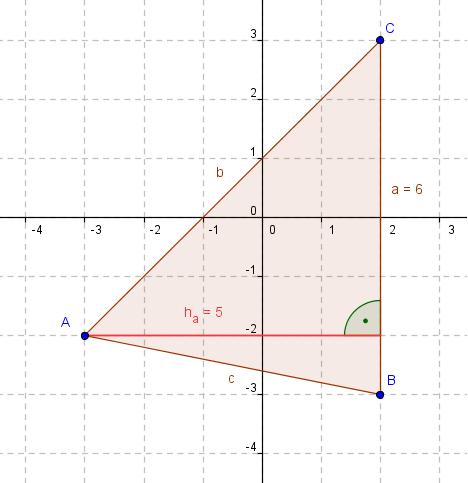Dreieck: Unterschied zwischen den Versionen
Aus RMG-Wiki
(Die Seite wurde neu angelegt: '''Diese Seite wird gerade bearbeitet!''') |
|||
| (10 dazwischenliegende Versionen von einem Benutzer werden nicht angezeigt) | |||
| Zeile 1: | Zeile 1: | ||
| − | ''' | + | ==1. Aufgabe== |
| + | |||
| + | <div style="margin:0px; margin-right:90px; border:thick double green; padding: 1em 1em 1em 1em; background-color:white; width:50%; align:center; "> | ||
| + | <span style="color: green">'''Arbeitsauftrag:'''</span> | ||
| + | *Zeichne die Punkte A(-3|-2), B(2|-3) unc C(2|3). | ||
| + | *Verbinde sie zu einem Dreieck. | ||
| + | *Berechne die Fläche. | ||
| + | </div> | ||
| + | |||
| + | {{Lösung versteckt|[[Bild:Dreieck Test.jpg]]}} | ||
| + | |||
| + | |||
| + | ==2. Aufgabe== | ||
| + | |||
| + | '''Seite 118, Aufgabe 11''' | ||
| + | |||
| + | {{Lösung versteckt| | ||
| + | '''1. Drachenviereck:''' | ||
| + | |||
| + | Die Diagonale f teilt das Dreieck in zwei gleichgroße Teildreiecke. Die Hälfte der Diagonalen e ist die Höhe der Dreiecke. | ||
| + | |||
| + | Die Fläche eines Teildreiecks errechnet sich aus: | ||
| + | |||
| + | A<math>=</math> <math>(</math> f<math>\cdot</math>e : 2 <math>)</math> : 2 | ||
| + | |||
| + | A<math>=</math>7 dm <math>\cdot</math> 4 dm : 2 : 2 | ||
| + | |||
| + | A<math>=</math>7 dm² | ||
| + | |||
| + | Das Drachenvierreck besteht aus zwei Teildreiecken. | ||
| + | |||
| + | A<sub>ges</sub><math>=</math>7 dm² + 7 dm² <math>=</math> 14 dm² | ||
| + | |||
| + | <br> | ||
| + | |||
| + | '''2. Drachenvierreck''' | ||
| + | |||
| + | A<math>=</math>80 dm<math>\cdot</math>39 dm : 2<math>\cdot</math>2 | ||
| + | |||
| + | A<math>=</math>3120 dm² | ||
| + | |||
| + | }} | ||
| + | |||
| + | |||
| + | ==3. Aufgabe== | ||
| + | |||
| + | '''Seite 119, Aufgabe 15 a)''' | ||
| + | |||
| + | {{Lösung versteckt| | ||
| + | A<math>=</math>a<math>\cdot</math>h<sub>a</sub> : 2 <math>=</math> 6 cm <math>\cdot</math> 3 cm : 2<math>=</math>9 cm² | ||
| + | |||
| + | a<sub>neu</sub><math>=</math>10 cm | ||
| + | |||
| + | h<sub>a,neu</sub><math>=</math> A : a <math>\cdot</math> 2 <math>=</math> 900mm² : 100 mm <math>\cdot</math> 2 <math>=</math> 18 mm <math>=</math> 1,8 cm | ||
| + | |||
| + | |||
| + | }} | ||
| + | |||
| + | <br> | ||
| + | |||
| + | ---- | ||
| + | |||
| + | <big>[[Lernpfad Flächenberechnung/Inhaltsverzeichnis|Hier]]</big> kommst du zurück zum Inhaltsverzeichnis. | ||
Aktuelle Version vom 26. September 2010, 23:10 Uhr
1. Aufgabe
Arbeitsauftrag:
- Zeichne die Punkte A(-3|-2), B(2|-3) unc C(2|3).
- Verbinde sie zu einem Dreieck.
- Berechne die Fläche.
2. Aufgabe
Seite 118, Aufgabe 11
1. Drachenviereck:
Die Diagonale f teilt das Dreieck in zwei gleichgroße Teildreiecke. Die Hälfte der Diagonalen e ist die Höhe der Dreiecke.
Die Fläche eines Teildreiecks errechnet sich aus:
A
 f
f e : 2
e : 2  : 2
: 2
A 7 dm
7 dm  4 dm : 2 : 2
4 dm : 2 : 2
A 7 dm²
7 dm²
Das Drachenvierreck besteht aus zwei Teildreiecken.
Ages 7 dm² + 7 dm²
7 dm² + 7 dm²  14 dm²
14 dm²
2. Drachenvierreck
A 80 dm
80 dm 39 dm : 2
39 dm : 2 2
2
A 3120 dm²
3120 dm²
3. Aufgabe
Seite 119, Aufgabe 15 a)
A a
a ha : 2
ha : 2  6 cm
6 cm  3 cm : 2
3 cm : 2 9 cm²
9 cm²
aneu 10 cm
10 cm
ha,neu A : a
A : a  2
2  900mm² : 100 mm
900mm² : 100 mm  2
2  18 mm
18 mm  1,8 cm
1,8 cm
Hier kommst du zurück zum Inhaltsverzeichnis.


